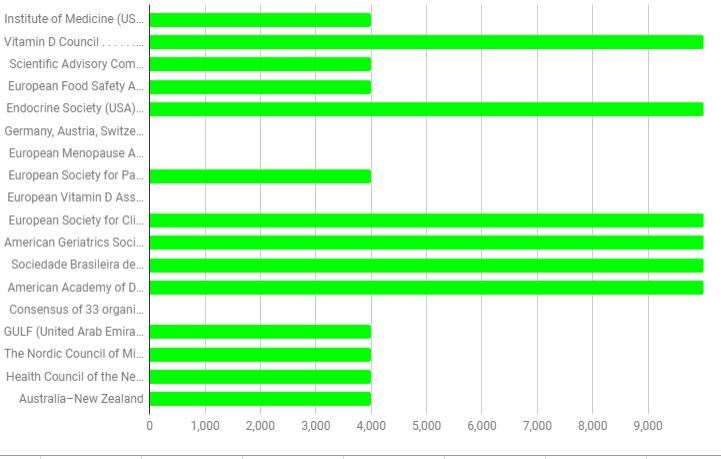Vitamin D Consensus 4,000 to 10,000 IU, upper limit 100 ng – Italy 2018
Consensus statement from 2nd International Conference on Controversies in Vitamin D
Rev Endocr Metab Disord. 2020; 21(1): 89–116. doi: 10.1007/s11154-019-09532-w
A. Giustina,1,2 R. A. Adler,3 N. Binkley,4 J. Bollerslev,5,6 R. Bouillon,7 B. Dawson-Hughes,8 P. R. Ebeling,9 D. Feldman,10 A. M. Formenti,1,2 M. Lazaretti-Castro,11 C. Marcocci,12 R. Rizzoli,13 C. T. Sempos,14 and J. P. Bilezikiancorresponding author15
 * MS and vitamin D consensus from Brazil - 40-100 ng, not monotherapy – Feb 2014
* 30 to 50 ng of vitamin D is optimal – Central Europe consensus Sept 2013
* Seniors need at least 4,000 IU vitamin D, no test needed – Consensus Jan 2014
* * High Risk category listing has items along with related searches
* The consensus fails to consider as high risk: obese, dark skin, little access to sun, spinal cord injury, Sickle Cell,
* Overview Toxicity of vitamin D - many groups consider toxicity to be >150 ng, not >100 ng
* Vitamin D (40-70 ng) in Children’s Health – review Sept 2014
* Is 50 ng of vitamin D too high, just right, or not enough
* Vitamin D has already cleared 100 percent of lesions from over 1,000 MS patients in Brazil
* After achieving 150 ng** of vitamin D, but not with monotherapy
* Dr. who got patients to vitamin D level of 80 ng
* 2,500 patients became extremely healthy: visits dropped from 4/year down to 1/year
* MS and vitamin D consensus from Brazil - 40-100 ng, not monotherapy – Feb 2014
* 30 to 50 ng of vitamin D is optimal – Central Europe consensus Sept 2013
* Seniors need at least 4,000 IU vitamin D, no test needed – Consensus Jan 2014
* * High Risk category listing has items along with related searches
* The consensus fails to consider as high risk: obese, dark skin, little access to sun, spinal cord injury, Sickle Cell,
* Overview Toxicity of vitamin D - many groups consider toxicity to be >150 ng, not >100 ng
* Vitamin D (40-70 ng) in Children’s Health – review Sept 2014
* Is 50 ng of vitamin D too high, just right, or not enough
* Vitamin D has already cleared 100 percent of lesions from over 1,000 MS patients in Brazil
* After achieving 150 ng** of vitamin D, but not with monotherapy
* Dr. who got patients to vitamin D level of 80 ng
* 2,500 patients became extremely healthy: visits dropped from 4/year down to 1/year
📄 Download the PDF from VitaminDWiki
The 2nd International Conference on Controversies in Vitamin D was held in Monteriggioni (Siena), Italy, September 11-14, 2018. The aim of this meeting was to address ongoing controversies and timely topics in vitamin D research, to review available data related to these topics and controversies, to promote discussion to help resolve lingering issues and ultimately to suggest a research agenda to clarify areas of uncertainty. Several issues from the first conference, held in 2017, were revisited, such as assays used to determine serum 25-hydroxyvitamin D [25(OH)D] concentration, which remains a critical and controversial issue for defining vitamin D status. Definitions of vitamin D nutritional status (i.e. sufficiency, insufficiency and deficiency) were also revisited. New areas were reviewed, including vitamin D threshold values and how they should be defined in the context of specific diseases, sources of vitamin D and risk factors associated with vitamin D deficiency. Non-skeletal aspects related to vitamin D were also discussed, including the reproductive system, neurology, chronic kidney disease and falls. The therapeutic role of vitamin D and findings from recent clinical trials were also addressed.
The topics were considered by 3 focus groups and divided into three main areas:
1) “Laboratory”: assays and threshold values to define vitamin D status;
2) “Clinical”: sources of vitamin D and risk factors and role of vitamin D in non-skeletal disease and
3) “Therapeutics”: controversial issues on observational studies and recent randomized controlled trials.
In this report, we present a summary of our findings.
